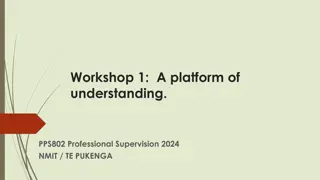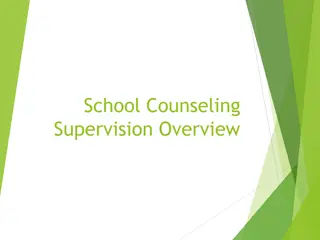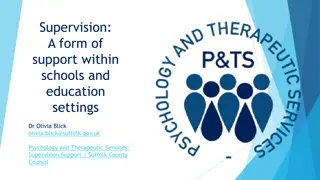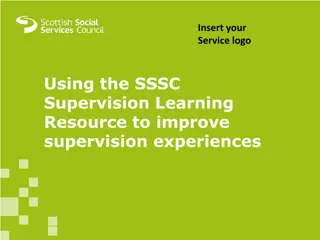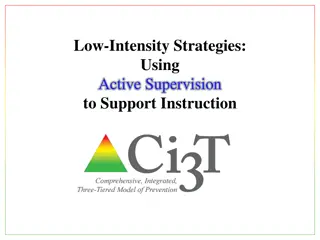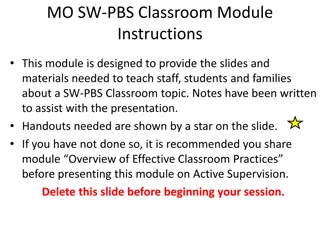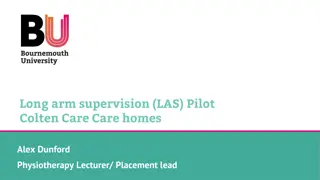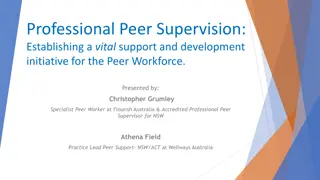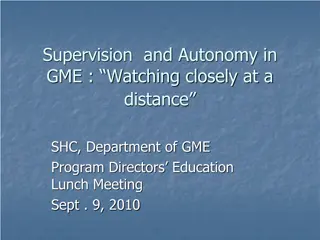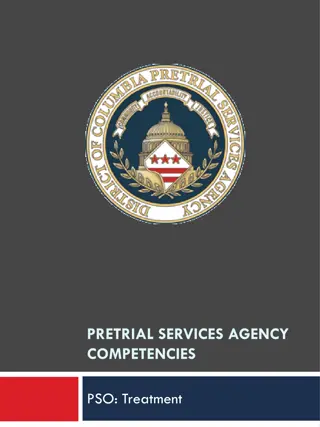Enhancing Clinical Supervision for Effective Treatment Planning
This content discusses the importance of shifting the practice model in supervision towards supporting cultural change and operationalizing sustainable initiatives. It emphasizes the critical role of supervisors in fostering a collaborative approach to treatment planning and assessment, focusing on personal change and transformation. The content underscores the need for a responsive organizational culture and risk-taking behavior in facilitating learning and development within clinical teams.
Download Presentation

Please find below an Image/Link to download the presentation.
The content on the website is provided AS IS for your information and personal use only. It may not be sold, licensed, or shared on other websites without obtaining consent from the author. Download presentation by click this link. If you encounter any issues during the download, it is possible that the publisher has removed the file from their server.
E N D
Presentation Transcript
+ Taking Back Supervision TCOM, Treatment Planning and Clinical Supervision April D. Fernando, PhD Chapin Hall at the University of Chicago Erin Rosenblatt, PsyD WestCoast Children s Clinic
Transformational.Our work is focused on the the personal change that is the reason for intervention. Collaborative. A shared vision approach is used not one person s perspective. Outcomes. The measures are relevant to the decisions about the approach or purpose of the interventions. Management. The information is used is used in all aspects of managing the system from individual/ family planning to clinical supervision to program and system operations.
+Shifting the Practice Model A responsive organizational culture is a prerequisite to embedding sustainable initiatives. A collective orientation towards learning is necessary for cultural change. Developing a learning organization involves changes in attitudes, practices, and structures. Risk-taking behavior is essential in the context of any change, providing lessons are learnt from the successes and failures of these behaviors and incorporated into future structures. Leaders of change have to be an integral part of the clinical team and be adequately supported with basic resources, such as personnel, time, and other facilitative mechanisms.
+Shifting the Practice Model Supervisors have a critical leadership role in operationalizing and supporting cultural change. For the TCOM: Supervisors are key in determining whether the CANS/ANSA remains a tool that is given, or is a strategy that helps clients, families and providers collaborate and communicate, and supports tracking personal change and transformation. Need to reclaim the supervision hour as one for consultation, support and training.
+Supervision C-A-T-AP-ult Context Assessment Treatment Planning Attending to Progress Adapted from San Francisco County s Family Driven Supports: Families Teach Best Practices in Assessment
+Supervision C-A-T-AP-ult Context context Identify effective practices for engaging families Highlight individual/family experiences and Assessment Teach strategies that lead to a collaborative assessment experience Teach a process for individuals/families to review and finalize the assessment with the clinician Teach strategies for creating a shared treatment plan Teach a process for consistent review of the treatment plan Treatment Planning Practice using CANS/ANSA in communication with individual/family Use CANS/ANSA data as feedback on intervention impact and to monitor progress Attending to Progress Adapted from San Francisco County s Family Driven Supports: Families Teach Best Practices in Assessment
+Supervision C-A-T-AP-ult Context context Identify Effective practices for engaging families Highlight individual/family experiences and Assessment Treatment Planning Attending to Progress Adapted from San Francisco County s Family Driven Supports: Families Teach Best Practices in Assessment
+Attending to the Context Clients and Families often have experiences with multiple systems that have been built with the stated goal of helping families and communities. Many times, however, contact with people in these systems has not helped the family, client or the community. For change to occur, clients and families must actively participate in every step of the treatment process. Their engagement in the goals and tasks of treatment is related to better outcomes/change. Goal: Collaboration, Communication, Transparency and Shared Vision
+Barriers to Engagement: Negative Interactions Coming in to an interaction with assumptions about the family, caregiver or client. Failing to explain the reason for the various aspects of treatment (e.g., assessment, setting goals, participation, etc.). Not being engaged and attentive. Not sharing with the individual or family what is written about them. Using information in a way that blindsides the client or family. Approaching interactions as doing things to or for the client/family rather than supporting the client/family doing things for themselves.
+Engagement: What Can Help? Teach a Strengths Approach: Models respect and kindness towards individuals and families. Builds Trust. Conveys the belief in them to continue healthy development and change when needed. Empowering. Conveys high expectations of the individual and family even while addressing areas of challenge. Hopeful.
+Supervision C-A-T-AP-ult Context Assessment Teach strategies that lead to a collaborative assessment experience Teach a process for individuals/families to review and finalize the assessment with the clinician Treatment Planning Attending to Progress Adapted from San Francisco County s Family Driven Supports: Families Teach Best Practices in Assessment
+The Assessment: Overview Assist with planning and structuring a comprehensive assessment. TCOM requires a lot of front-end work. Some tips from clients and families: Reassure us that we ve done the right thing by coming in (lead us where we can get what we need) Tell us a little bit about who you are (No robots) ..and your work with families like mine (No freaking out, thinking I am/my child is the worst one) Be clear about the supports you can offer Tell us who will see the assessment
+ Identify Needs/Strengths Accomplish Goals Set Goals Strategies/Interve ntions Make Adjustments Track Progress Give Feedback
+The Assessment: CANS/ANSA Spend time practicing how each domain will be introduced; go over potentially challenging items. Help clinician identify a process to resolve disagreements in rating items, and how to handle situations when a consensus regarding a rating is not possible. Help clinician in writing the assessment in client/family friendly language and being transparent.
+The Assessment: CANS/ANSA Prior to presenting the assessment and CANS/ANSA to the client and/or family, review ratings and practice how to discuss the assessment. When reviewing strengths, begin to operationalize each strength for the individual/family: how does the strength serve the individual? In discussing needs, begin to prioritize needs and identify patterns: do any underlying needs emerge?
+Assessment: Questions to Consider for Supervision Clinicians: Were there any items on the CANS/ANSA the clinician struggled to score for this client/family? Did the client have any elevated scores in the trauma domains? Did s/he have elevated scores in other domains that you believe are somehow related to his/her history of trauma exposure? Have the CANS scores been shared with the client and/or caregiver? Why not or how did this go? Caseworkers: Is the Caseworker bringing the CANS/ANSA to supervision? Does the casework supervisor agree with the caseworkers scoring of the CANS/ANSA? Given the verbal description of cases in supervision are the scores valid: too high or too low? Is all pertinent information discussed in supervision reflected in the CANS? How does the caseworker completed CANS compare to other completed CANS (e.g. the therapist CANS or the Initial Assessment screener?) Adapted from Using the CANS in Working with Complexly Traumatized Children and Adolescents: Creative Applications for Different Professional Roles
+Supervision C-A-T-AP-ult Context Assessment Teach strategies for creating a shared treatment plan Treatment Planning Teach a process for consistent review of the treatment plan Attending to Progress Adapted from San Francisco County s Family Driven Supports: Families Teach Best Practices in Assessment
+Treatment Planning: Mike Example Peer/Social Experiences 3 Service Permanence 0 Knowledge of Illness 2 Relationship Permanence 1 Intimate Relations 2 Resourcefulness - 1 Impulse Control 2 Substance Use 2 Job Functioning 3 Sanction Seeking Behavior 2 Sexually Inappropriate Behavior 2 Crime 2 Talents/Interests 3 Resiliency 3
+Treatment Planning: Mike Example Sex. Inapp. Beh. Subst. Use Knowl. of Illness Intimate Relation. Sex. Inapp Beh Impulse Control CASE MANAGER MIKE Subst. Use Impulse Control Job Peer/Social Experiences Functioning Knowl of Illness Knowl of Illness MOTHER GRP THERAPIST
+Treatment Planning: Collaborative Case Conceptualization Connecting the dots. Helping clients/families understand their lives from past to the present, outlining how a particular difficulty has developed, persisted and the various cognitive, emotional, behavior effects and interpersonal difficulties generated as a consequence. Critical aspect of treatment. Sharing the case conceptualization has the potential to facilitate the individual s therapeutic experience, insight and understanding; can facilitate client s/family s experience of feeling understood. Collaborative and co-created is key. To be effective, case formulation must be a collaborative endeavor, comprise the client and family s views and beliefs, and not imposed (covertly or otherwise). Facilitates transparency in the treatment.
+Treatment Planning: Collaborative Case Conceptualization Treatment Plan Support clinicians in working with clients/families to develop a understanding of the current challenges. The client/individual s case conceptualization should integrate information from the CANS/ANSA. Symptoms & Problems Precipitating Stressors Predisposing Events Strengths & Assets
+Treatment Planning Intervention/Str ategy Goal Objective Timeframe What steps must be taken to accomplish the personal change? What personal change will happen ? What specific interventions or strategies have been identified to address the goals and objectives? What is the estimated length of time to achieve personal change? What CANS life functioning area will improve? What CANS needs or strengths must improve? Some Tips: Minimum standard: What would be enough change to keep the client functioning in that environment? Make sure that everyone has the same idea about each goal. Be clear about timelines for goals How long does it usually take to see some relief? Will it get worse before it gets better? What do I do when it feels like what you ve told me isn t working? How long is too long?
+Treatment Planning: Hot Spots to Supervise What if family members disagree about whether an item requires intervention? Practice reframing issues and focus on functioning. What items do I present to families? Practice linking the CANS/ANSA items to the client/family case conceptualization, and then to the objective and goals. It will help identify which items to prioritize and address.
+Treatment Planning: Hot Spots to Supervise How do we create specific goals that address underlying needs and utilize strengths? Practice identifying underlying needs and developing strategies and interventions to address them. This should be done with the family. What if we re not making progress? Develop process of having CANS/ANSA data integrated into supervision and sessions with clients/families. Practice discussing CANS/ANSA data as outcome metrics: does the plan need to be changed in light of the data?
+Treatment Planning: Questions to Consider for Supervision Clinicians: Did your CANS scores drive your treatment plan? How or why not? What have you done/do you plan to do to address safety and self-regulation in therapy with this child (two very common needs for clients with complex trauma)? Are there other key people in this client s life that can assist in addressing any of the client s needs or building his/her strengths (community/natural supports, other professionals)? Have you done any psychoeducation with the client s caregivers, parents, school, or other involved providers to assist them in understanding (and managing) the client s behavior? When applicable, have you focused on the caregiver section of the CANS/ANSA to identify the areas for building family resilience? Caseworkers: Has the caseworker identified all actionable items and usable strengths and incorporated these into service plan outcome/goal statements? Before signing off on any significant decisions, has the casework supervisor reviewed the CANS to determine if CANS scores support placement or other decisions (e.g. return home, residential placement, etc.)? Adapted from Using the CANS in Working with Complexly Traumatized Children and Adolescents: Creative Applications for Different Professional Roles
+Supervision C-A-T-AP-ult Context Assessment Treatment Planning Practice using CANS/ANSA in communication with individual/family Attending to Progress Use CANS/ANSA data as feedback on intervention impact and to monitor progress Adapted from San Francisco County s Family Driven Supports: Families Teach Best Practices in Assessment
+Attending to Progress Identify patterns of success to understand and emulate, and identify areas to act on and improve When successes occur, find a way to celebrate them with clients/families; let them own their successes Find a way to build services based on both clinical experience and clinical science Identify training / supervision needs
+Attending to Progress Life Functioning Domain Hot Spots to Supervise Sleep Medical Are we making progress? Develop process of having CANS/ANSA data integrated into supervision and sessions with clients/families. Judgment Recreational CANS 3 Review clients needs and strengths data Developmental CANS 2 CANS 1 Making meaning: Identify patterns in the data and actions needed Social Functioning School Behavior Living Situation Family 0 1 2 3
+Attending to Progress Complex Trauma Core Components Hot Spots to Supervise: 38% Safety What if we re not making progress? 30% Self Regulation 29% Practice discussing CANS/ANSA data as outcome metrics: Does the plan need to be changed in light of the data? 26% 25% 23% 24% Rel Engagement 21% 21% 20% Self Refl Info Proc 15% Pos Affect Enhancmnt 13% 12% 10% 8% 8% Trauma Exp Integr 7% 0% Time 1 Time 2
+Attending to Progress: Questions to Consider for Supervision Clinician How often/when is the CANS administered during treatment? What is the plan for sharing feedback about client change overtime as a method of discussing both areas of growth and continued need? Caseworker Is the caseworker identifying changes in CANS item scores over time (up or down) by comparing sequential CANS and discussing the utility of the services provided in relation to specific CANS scores (i.e. no change in school achievement over 12 months is tutoring effective)? Adapted from Using the CANS in Working with Complexly Traumatized Children and Adolescents: Creative Applications for Different Professional Roles
+ April D. Fernando, PhD Policy Fellow Chapin Hall at the University of Chicago 1313 E 60th Street Chicago, IL 60637 Office: (773) 256-5170 Email: afernando@chapinhall.org www.chapinhall.org Thanks for your time! Erin Rosenblatt, PsyD Director of Training WestCoast Children s Clinic 3301 E. 12th Street, Ste 259 Oakland, CA 94601 Office: (510) 269-9107 Email: erosenblatt@westcoastcc.org www.westcoastcc.org Please feel free to contact us.





